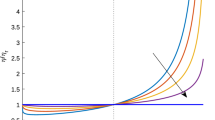Abstract
This paper establishes functional central limit theorems describing the heavy-traffic behavior of open single-class queueing networks with service interruptions. In particular, each station has a single server which is alternatively up and down. There are two treatments of the up and down times. The first treatment corresponds to fixed up and down times and leads to a reflected Brownian motion, just as when there are no service interruptions, but with different parameters. To represent long rare interruptions, the second treatment has growing up and down times with the up and down times being of ordern andn 1/2, respectively, when the traffic intensities are of order 1-n−1/2. In this case we establish convergence in the SkorohodM 1 topology to a multidimensional reflection of multidimensional Brownian motion plus a multidimensional jump process.
Similar content being viewed by others
References
S. Asmussen, The heavy traffic limit of a class of Markovian queueing models, Oper. Res. Lett. 6 (1988) 301–306.
P. Billingsley,Convergence of Probability Measures (Wiley, New York, 1968).
D.Y. Burman, Approximations for a service system with interruptions, AT&T Bell Laboratories, Murray Hill, NJ (1987).
H. Chen and A. Mandelbaum, Leontief systems, RBV's and RBM's, in:Proc. Imperial College Workshop on Applied Stochastic Processes, eds. M.H.A. Davis and R.J. Elliot (Gordon and Breach, London, 1991).
H. Chen and A. Mandelbaum, Discrete flow networks: bottleneck analysis and fluid approximation, Math. Oper. Res. 16 (1991) 408–446.
H. Chen and A. Mandelbaum, Discrete flow networks: diffusion approximations and bottlenecks, Ann. Prob., 19 (1991) 1463–1519.
H. Chen and A. Mandelbaum, Strong approximations for open queueing networks, in preparation.
E.G. Coffman, Jr., and M.I. Reiman, Diffusion approximations for computer communication systems, in:Mathematical Computer Performance and Reliability, eds. G. Iazeolla, P.J. Courtois and A. Hordijk (Elsevier, Amsterdam, 1984) pp. 33–53.
P. Dupuis and H. Ishii, On when the solution to the Skorohod problem is Lipschitz continuous, with applications, Department of Mathematics and Statistics, University of Massachusetts, Amherst (1989).
W. Feller,An Introduction to Probability Theory and its Applications, Vol. II, 2nd ed. (Wiley, New York, 1971).
K.W. Fendick, V.R. Saksena and W. Whitt, Dependence in packet queues, IEEE Trans. Commun. 37 (1989) 1173–1183.
M.J. Fischer, An approximation for queueing systems with interruptions, Manag. Sci. 24 (1977) 338–344.
P.W. Glynn and W. Whitt, A central-limit-theorem version ofL = λW, Queueing Systems 2 (1986) 191–215.
P.W. Glynn and W. Whitt, Ordinary CLT and WLLN versions ofL = λW, Math. Oper. Res. 13 (1988) 674–692.
P.W. Glynn and W. Whitt, Departures from many queues in series, Ann. Appl. Prob. 1 (1991) 546–572.
J.M. Harrison, Brownian models of queueing networks with heterogenous customer populations, in:Stochastic Differential Systems, Stochastic Control Theory and Applications, eds. W. Fleming and P.L. Lions (Springer, New York, 1988) pp. 147–186.
J.M. Harrison and M.I. Reiman, Reflected Brownian motion on an orthant, Ann. Prob. 9 (1981) 302–308.
J.M. Harrison and R.J. Williams, Multidimensional reflected Brownian motions having exponential stationary distributions, Ann. Prob. 15 (1987) 115–137.
J.M. Harrison and R.J. Williams, Brownian models of open queueing networks with homogeneous customer populations, Stochastics 22 (1987) 77–115.
L. Horvath, Strong approximation of open queueing networks, Math. Oper. Res. 17 (1992) 487–508.
D.P. Johnson, Diffusion approximations for optimal filtering of jump processes and for queueing networks, Ph.D. Dissertation, Department of Mathematics, The University of Wisconsin, Madison (1983).
O. Kella and W. Whitt, Diffusion approximations for queues with server vacations, Adv. Appl. Prob. 22 (1990) 706–729.
A. Mandelbaum, The dynamic complementarity problem, Graduate School of Business, Stanford University (1989).
J.L. Pomarede, A unified approach via graphs to Skorohod's topologies on the function spaceD, Ph.D. Dissertation, Department of Statistics, Yale University (1976).
M.I. Reiman, Open queueing networks in heavy traffic, Math. Oper. Res. 9 (1984) 441–458.
A.V. Skorohod, Limit theorems for stochastic processes, Theor. Prob. Appl. 1 (1956) 261–290.
W. Whitt, Weak convergence theorems for queues in heavy traffic, Ph.D. Dissertation, Cornell University (1968).
W. Whitt, Preservation of rates of convergence under mappings, Z. Wahrscheinlichkeitstheorie verw. Gebiete 29 (1974) 39–44.
W. Whitt, The continuity of queues, Adv. Appl. Prob. 6 (1974) 175–183.
W. Whitt, Some useful functions for functional limit theorems, Math. Oper. Res. 5 (1980) 67–85.
Author information
Authors and Affiliations
Rights and permissions
About this article
Cite this article
Chen, H., Whitt, W. Diffusion approximations for open queueing networks with service interruptions. Queueing Syst 13, 335–359 (1993). https://doi.org/10.1007/BF01149260
Received:
Issue Date:
DOI: https://doi.org/10.1007/BF01149260



